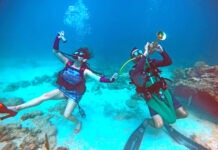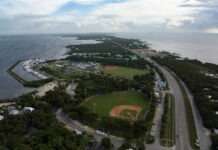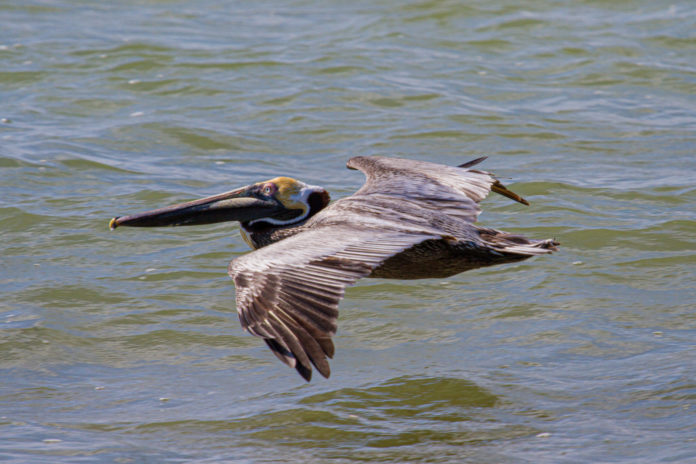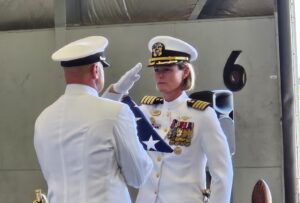I was on my way back from the mainland. Mostly I’d been wondering exactly how many empty cruisers the sheriff’s office had parked on the side of the road these days. There had always been that one in Layton, but they seemed to be everywhere now. It’s pretty interesting and a low-cost deterrent, assuming they are all old, out-of-service cars. Locals have no doubt figured out their locations pretty quick, but it probably keeps a good number of knucklehead tourists in line.
Midway through the Long Key Bridge I looked out the window and found myself eye to eye with a brown pelican.
The bird was flying parallel to the bridge, a couple feet over the cement barrier that kept you from driving into the water should you stray. He wasn’t flapping, he was gliding, hardly moving a muscle. And he wasn’t moving much slower than my car.
You never want to slow down too much on one of the bridges, but there was nobody behind me, and I wanted to see how fast that pelican was going. So I crept the car down to about 40 and just kind of kept pace with him.
Birds are the dinosaurs that lived, so it was ironic that the only way I could keep pace with him, while he seemed to be expending absolutely no energy, was by sitting in a 3,000-pound box made of glass and steel that moved by inefficiently burning the highly processed remains of his ancestors. (What a world!)
We stayed together 100, 200, 400 yards. Then with a slight tilt of his wing, the pelican dropped down below the barrier and out of my sight.
I’ve had this experience a few times with pelicans while driving across bridges in the Keys, though never regularly or predictably.
By the flags of the Cuban coffee stand at the end of the bridge he was flying into a headwind that was coming at him at about a 45 degree angle. (Looking at maps and weather data later, the bird was flying west-southwest and the wind was coming north-northwest at about 13 miles per hour.)
Pelicans are such odd-looking beasts. They have kind of a goofy, unserious reputation, which isn’t totally deserved. I think it’s the long bills with pouches, and the way they waddle when they walk, and the fact that it’s one of the first birds you learn to identify as a kid, right after the chicken.
They are, in fact, some of the most agile birds out there. They have the shape of John Goodman, but the grace of Fred Astaire.
You can often see this grace applied on really calm days, where they make use of a phenomenon known as ground effect to move at seemingly impossibly slow speeds across the water. In reality what is happening is that they are flying so low that the air that is pushed down by their wings is hitting the surface of the water and bouncing back up, creating a cushion, kind of like what carries a hovercraft or air hockey puck, and it requires less velocity for them to retain lift. It demands some incredible subtle movement to maintain.
If he was a sailboat, the Long Key Bridge pelican’s relation to the wind would be somewhere between close hauled and a close reach, and for a while I tried to figure out how the pelican was moving so fast in terms of sailing. But which point of sail is fastest depends on hull shape and design, and when I started thinking about what hull shape a pelican had, I realized it really wasn’t a good fit, sails working on the vertical and wings working on the horizontal and all.
There was an interesting study done in the 1990s on seabirds and in which winds they fly best. Apparently a pelican in a headwind can fly with ground speed between 20 and 30 mile per hour, which wouldn’t explain why this pelican was moving closer to 40.
I think some of the clues as to the pelican’s speed may be inherent in how it was flying in relation to the bridge – a few feet away, but rigidly parallel.
The wind was coming out of the Gulf and hitting the vertical concrete of the bridge, creating some sort of updraft, and the pelican was possibly gaining momentum to move along it the way a surfer gains speed moving parallel along the face of the wave. Also, as anyone who has ridden a bike along U.S. 1 can tell you, when cars and trucks pass, the turbulence that follows them gives you a bit of a tailwind push. And the cars driving across the bridge may have also been giving the pelican some speed that way.
Pelicans are some of the heaviest soaring birds out there. Your average brown pelican weighs 8 pounds and has a wingspan of 4 feet. Which makes them stable in situations smaller or lighter birds might not be.
Of course, to test all these theories out, you’d have to build a scale model of the bridge, complete with moving cars and flying pelicans, and then bring it into a wind tunnel, and then fire up a smoke machine and film it all with high-resolution cameras.
All that to figure out what a brown pelican knows instinctively.
















